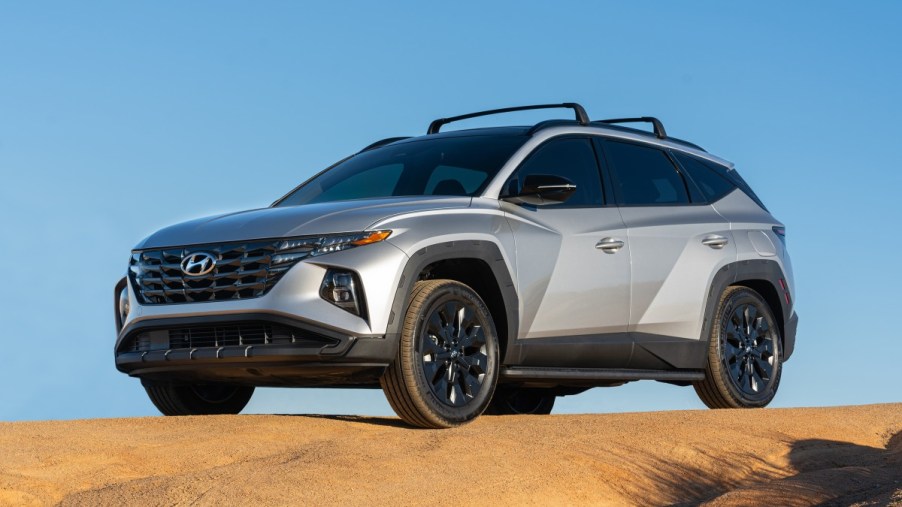
2023 Hyundai Tucson Beats the 2023 Mazda CX-5
Compact crossover SUVs are very popular these days, and two solid choices are the Hyundai Tucson and the Mazda CX-5. See how the two crossover SUVs compare in this 2023 Hyundai Tucson vs. 2023 Mazda CX-5 analysis. With its wide array of advantages, the Tucson beats the CX-5.
2023 Hyundai Tucson vs. 2023 Mazda CX-5

In this 2023 Hyundai Tucson vs. 2023 Mazda CX-5 crossover SUV comparison, we evaluated several areas. This includes performance, gas mileage, towing, off-road capabilities, safety, passenger and cargo space, warranty coverage, and price.
Tucson vs. CX-5: Performance and gas mileage

On the performance front, the 2023 Hyundai Tucson offers three engine options: a 2.5-liter four-cylinder engine (187 hp), a hybrid (226 hp), and a plug-in hybrid (261 hp). In comparison, the 2023 Mazda CX-5 offers two engine options: a 2.5-liter four-cylinder engine (187 hp) and a turbocharged 2.5-liter four-cylinder engine (256 hp).
While the two crossover SUVs have the same base engine horsepower output, the Tucson has a slightly higher maximum output with the plug-in hybrid model. However, with its tighter turning circle (36 vs. 38.6 feet), the CX-5 is more maneuverable.
For efficiency, the Tucson has the advantage. The fully gas-powered Tucson has an estimated fuel economy of up to 28 combined mpg, and the Tucson Hybrid has a gas mileage of up to 43 combined mpg. Also, the Tucson Plug-In Hybrid has a fuel efficiency of 84 MPGe when in electric-only mode and 35 combined mpg in hybrid mode.
In comparison, the CX-5 gets an estimated gas mileage of up to 26 combined mpg.
Tucson vs. CX-5: Towing
The two crossover SUVs are evenly matched for towing. Both the 2023 Tucson and the 2023 CX-5 can tow up to 2,000 pounds.
Tucson vs. CX-5: Off-road capabilities
Both crossover SUVs offer a traction-enhancing all-wheel drive system. However, the Tucson is the better choice for off-road use. For one, the Tucson has higher ground clearance than the CX-5 (up to 8.3 vs. 7.5 inches). Also, unlike the CX-5, the Tucson has an off-road-focused model with the rugged XRT trim.
Tucson vs. CX-5: Safety
The Tucson and CX-5 are safe vehicles. For the previous model year, both crossover SUVs earned an IIHS Top Safety Pick+ award, which is the highest possible IIHS rating. Given that the 2023 Tucson and the 2023 CX-5 are carryover models, they will likely have similar IIHS ratings for the new model year.
Tucson vs. CX-5: Passenger and cargo space
The Tucson is bigger than the CX-5, resulting in more interior space. It has a total passenger volume of 108 cu-ft and a maximum cargo capacity of up to 80.3 cu-ft. In comparison, the CX-5 has a total passenger volume of up to 104 cu-ft and a maximum cargo capacity of 58.1 cu-ft.
Tucson vs. CX-5: Warranty coverage
For warranty coverage, the Tucson has a major advantage. It’s backed by a 5-year/60,000-mile basic warranty and a 10-year/100,000-mile powertrain warranty, compared to a 3-year/36,000-mile basic warranty and a 5-year/60,000-mile powertrain warranty for the CX-5. Also, unlike the CX-5, the Tucson has a free maintenance plan, with three years or 36,000 miles of coverage.
Tucson vs. CX-5: Price
Which crossover SUV costs more: the 2023 Tucson or the 2023 CX-5? The starting price of the 2023 CX-5 ranges from $26,700 MSRP for the 2.5 S trim up to $39,650 MSRP for the 2.5 Turbo Signature trim.
For the Tucson, the official price information is not yet available for the 2023 model year. However, the 2023 Tucson will probably cost slightly more than the 2022 Tucson. The starting price of the 2022 Tucson ranges from $24,950 MSRP for the SE trim up to $43,200 MSRP for the Limited Plug-In Hybrid trim.
2023 Hyundai Tucson vs. 2023 Mazda CX-5: Which crossover SUV is better?
In this 2023 Hyundai Tucson vs. 2023 Mazda CX-5 crossover SUV comparison, the 2023 Tucson has many advantages. This includes advantages for maximum horsepower output, gas mileage, off-road capabilities, passenger and cargo space, warranty coverage, and a free maintenance plan. Conversely, the 2023 CX-5 has the advantage for maneuverability.


